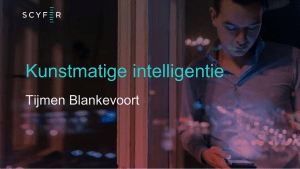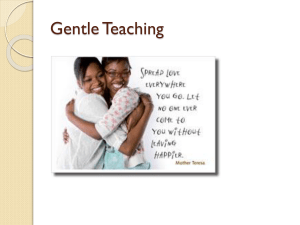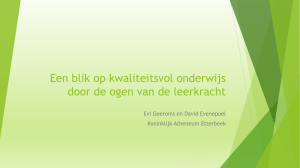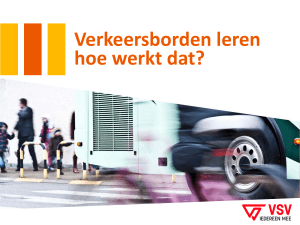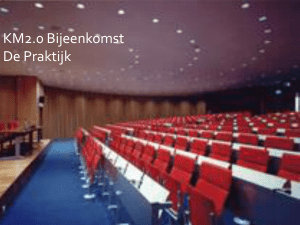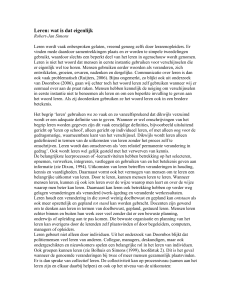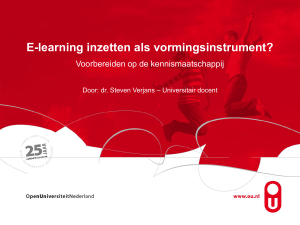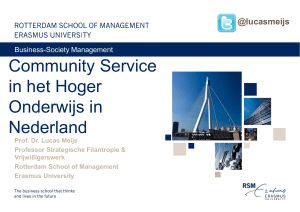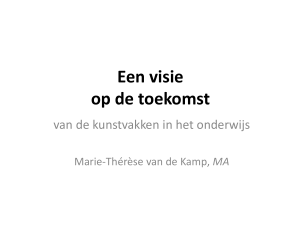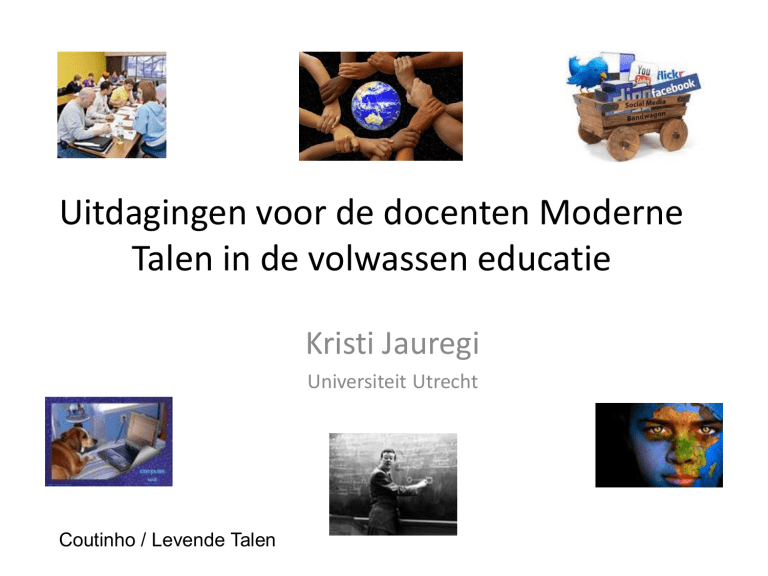
Uitdagingen voor de docenten Moderne
Talen in de volwassen educatie
Kristi Jauregi
Universiteit Utrecht
Coutinho / Levende Talen
Schema
1. Maatschappij
2. Onderwijs breed
3. Taalonderwijs
– Context (NT2 /MVT)
– Voorwaarden voor taalverwerving
– Grammatica
– Interactie
– Interculturele communicatie
– Web 2.0
1. Maatschappij
Globalisatie
Dynamisch
Snel
Lifelong learning
Creativiteit
Kofino
Netwerken
Samenwerking
Verbonden
Kofino
Kofino
Social media
Belang van
communicatie
& talen
Kofino
Cross-culturele communicatie
Meertaligheid:
1+2
Interculturele
competentie
Sociale cohesie
Kofino
Internet gebruik in Nederland
Waar gebruik je internet voor?
2. Onderwijs
Top down
Docent
Formeel onderwijs
80 % van kennis en vaardigheden wordt
opgedaan via: informeel leren
Studenten
Kofino
Onderwijs: leer en student gericht
Kofino
Kofino
Stimuleer de creativiteit!
Stimuleer de samenwerking
Kofino
Verandering in leertheorieën
Cognitivisme
Sociaal constructivisme
• Kennis wordt
verworven,
opeengestapeld
• Leren: individueel
gebeuren
• Kennis als betekenis die
wordt geconstrueerd
via taken
• Leren van en met
anderen
De vaardige docent van de 21ste eeuw
•
•
•
•
•
•
Is vertrouwd met gebruik computers
Is creatief
Is kritisch
Zoekt uitdagingen
Is constructief
Is verbonden (connected)
3. Moderne talen onderwijs: context
Verschillen NT2 / MTO?
•
•
•
•
Doelgroep
Behoeftes / Doelen
Toegang tot T2/VT input en interactie
Methodologie
Taalonderwijs:
vorwaarden
en principes
1.
Blootstelling aan begrijpelijk, gevarieerd en rijke input (i+1, Krashen, 1982,
1985).
2.
3.
4.
5.
Mogelijkheden om (pushed) output (Swain, 1985) te produceren, die
begrijpelijk, correct en adequaat is in de gesprekscontext (Lantolf, 2006).
Interactie in de doeltaal stimuleren in een sociale en authentieke context
(Lantolf, 2006; Kasper, 2001). In dit proces staat negotiation of meaning (Long,
1996) centraal.
In een betekenis georiënteerde onderwijsperspectief, moeten er
momenten zijn om aandacht te schenken aan formele taalelementen:
focus of form (Doughty & Willis, 1998; Long, 1996).
Het gebruik van strategieën moet gestimuleerd worden (Oxford, 2010;
Dörnyei et al 1997; Richards et al 2009).
6.
Focus op Interculturele Communicatie (Byram,1997; Kasper, 2001; Kramsch,
1993, 1998; Lo Bianco et al 1999; Müller-Jacquier, 2003).
Interactie centraal in leerprocessen
Taken
Met expert leeftijdsgenoten
Grammatica
• Een van de subcompetenties binnen de
communicatieve competentie
LINGUISTIC
COMPETENCES
Functional
competence
COMMUNICATIVE
LANGUAGE
COMPETENCES
Expressions
of folk
wisdom
Interaction
schemata
(Common European
Framework of Reference
for Languages: Learning,
Teaching, Assessment
Discourse
competence
Lexical
Grammatical
Phonological
…….
Semantic
Grammatica
• Onenigheid over welke methode de beste is
(onderzoek/docenten/studenten)(Ellis, 2006):
– Direct / indirect
– Impliciet / Expliciet
• Belangrijk om grammatica in de communicatieve
context te behandelen (focus on form) (Swain; 1996; Doughty
& William, 1998; Lightbown, 1998; Norris & Ortega, 2000; Ellis, 2002; Lyster,2004).
• Lessituatie: veel variabelen (Kumaravadivelu, 2009)
• Grammatica onderwijs: geen duidelijk beeld (Allwright,
1983)
• Post method: Drama grammar (Even, 2011)
Interculturele communicatie
Sociale cohesie
Wederzijds begrip
(Byram, 1997; Zarate et al. 2004; Kramsch)
Kofino
Belang van Web 2.0
NIFLAR Project
NIFLAR 2009-2011
Objectives:
• Enrich
• Innovate
• Improve
learning processes
Make them more rewarding!!
Blended learning
Learner centeredness
Telecollaboration
ICC
NIFLAR 2009-2011, Virtual environments:
Videocommunication
Adobe connect
Virtual worlds
Second Life
Open Sim
Experiences NIFLAR (2009-2011)
• 22 pilot experiences have been carried out in
video-communication and Second Life (OS),
• Both with secondary and tertiary learners
(A1-B2 / pre-service teachers)
• 430 students have participated in crosscultural sessions (1 to 1 / 1 to 2) (3 to 5
sessions per course once a week)
• Developed criteria for effective tasks
• 60 interaction tasks for Dutch, Portuguese,
Russian and Spanish have been developed &
tested.
• Data gathered for research
Voorbeeld videocommunicatie
Voorbeeld virtuele werelden
Research issues
Is there an added value in implementing virtual
interaction through video-communication & virtual
worlds in language teaching curricula?
1. What are foreign language learners’ experiences?
2. Is there any impact on motivation?
3. Is there any indication suggesting that learners learn
more if they have the opportunity to engage in
networked interaction with experts according to
relevant tasks?
4. What happens during those cross-cultural
interactions?
Foreign language learners’ experiences:
positive aspects
“Step by step you learn to speak more easily in the target
language without feeling any boundaries. It improves
your talking skills”
“We learned a lot of new words, known culture
and lifestyle in the Netherlands. I have no fear
of speaking”
“I had an opportunity to talk with a native
speaker which is not very frequent in the
language course. We had also interesting
tasks, so it was something different than a
normal lesson”
“Personally I think that the greatest thing is that we made
new friends from the Netherlands so we can keep in touch
and keep improving”
Impact on motivation
Average Answer
5
Competence
VC
4
C
VC
3
C
VC
C
VC
SL
SL
SL
1
2
3
C
VC
VC
SL
VC
C
SL
SL
C
C
5
6
7
SL
2
5 point Likert
scale
Start interaction
sessions
4
Week
Spanish
Learning effect. Results.
Interaction effect between condition and pre- and post-tests was found to be significant. In other words, the
difference between pre- and post- test scores depends on the specific condition (F 2, 34 = 5.01; p = .012).
8.0
VW
7.2
C
SL
Score
6.4
5.6
4.8
VW
C
SL
4.0
Pre
Post
The results show that the difference between pre- and post- oral tests depends on the specific
condition. Especially in the SL and VWC condition students show on average more progression than
in the control condition. Hence, both SL and VWC have an additive effect on students’ test scores.
Interaction analysis
•
•
•
Learners exposed to very rich input (i+1; pragmatic adequacy).
Learners use language meaningfully (output hypothesis + ICC).
Varied sequences of negotiation of cultural and linguistic
meaning emerge.
Authenticity of interaction.
Positive learning atmosphere. It is fun!
Differences VC v. SL:
•
•
•
–
–
VC static, visual added value (gestures),
more quantity of talk
SL dynamic, creative, unexpected L use
linguistic focus, more silences
EV
en España no hay muchas personas que van en
bici / hora / un poco por / en las grandes
ciudades empiezan a construir carriles bici
para//
EU1
¿carriles?
carriles bici es la vía por donde va la
bicicleta porque Valencia es una gran ciudad
donde hay mucho / muchos coches / entonces
ellos
fabrican
una
pequeña
vía
especial
solamente para bicicletas
EV
EU1
EU1
okei
está pintada en rojo y nosotros vamos /
bicicletas / es más seguro ir por
carril bici / pero es muy nuevo / es
concepto de hace cuatro o cinco años
normalmente los españoles cogen mucho
coche
okei
EV
es una pena
EU1
en Holanda hay muchos carriles bici
EV
la
el
un
/
el
Meer weten, doen?
• NIFLAR: www.niflar.eu; www.niflar.ning.com
• Euroversity: www.euroversity.ning.com / TILA
• NL: 3DLes (de NIFLAR sims, Chatterdale, Parolay and …more
GRID locations)
• Utrecht Summerschool 2012 NIFLAR Comenius course:
in Utrecht (week 32) & Valencia (week 42)
SURF - OWD2011
Hartelijk dank!
•
•
•
•
•
•
•
•
•
•
•
•
•
•
•
•
Byram, M. (1997). Teaching and Assessing Intercultural Communicative Competence. Clevedon: Multilingual
Matters.
Dörnyei, Z.; Scott, M. (1997). "Communication strategies in a second language: definitions and taxonomies".
Language Learning 47: 173–210.
Doughty, C. & Williams, J. (1998). Focus on form in classroom second language acquisition. Cambridge:C.U.P.
Ellis, R. (2002). The place of grammar instruction in second/foreign curriculum. In E. Hinkel & S. Fotos (eds.)
New perspectives on grammar teaching in L2 learning. Mahway: Erlbaum. 00 17-34
Even, S. (2011). Drama Grammar: towards a performative postmethod peagogy. The Language Learning
Journal, 39/3. 299-312.
Hinkel, E. (ed.) (2004). Culture in Second Language Teaching and Learning. Cambridge: Cambridge University
Press.
Kramsch, C. (1993). Context and Culture in Language Teaching. Oxford: Oxford University Press
Kramsch, C. 1998. Language and culture. Oxford: O.U.P.
Kumaradivelu, B. (2009). Understanding Language Teaching. From method to postmethod.New York:Routledge.
Lantolf, J.P., & Thorne, S.L. (eds.) (2006). Sociocultural Theory and Second Language Learning. Oxford: Oxford
University Press.
Lo Bianco et al (1999). Striving for the Third Place: Intercultural Competence through Language Education.
Melbourne: Clearinghouse.
Long, M. (1996). The role of the linguistic environment in L2 acquisition. In Handbook of L2 acquisition, ed. W.
Rirchie & T.K. Bhatia, 413-468. San Diego:
Müller-Jacquier, J. (2003). Linguistic awareness and cultures. In Jürgen (Ed.) Studien zur internationalen
Internehmenskommunikation (pp. 20-49). Leipzig: Popp.
Richards, Jack C.; Schmidt, Richard, eds (2009). "Communication strategy". Longman Dictionary of Language
Teaching and Applied Linguistics. New York: Longman.
Swain, M. (1985). Communicative competence. Some roles of comprehemsible input and comprehensible
output in its development. In Input in second language acquisition, ed. S. Gass & C. Madden, 235-253. Rowley:
Newbury.
Vygotsky, L.S. (1962). Thought and Language. Massachusetts: MIT Press.
• http://www.youtube.com/watch?v=Fnh9q_cQcUE&feature=related (educ

